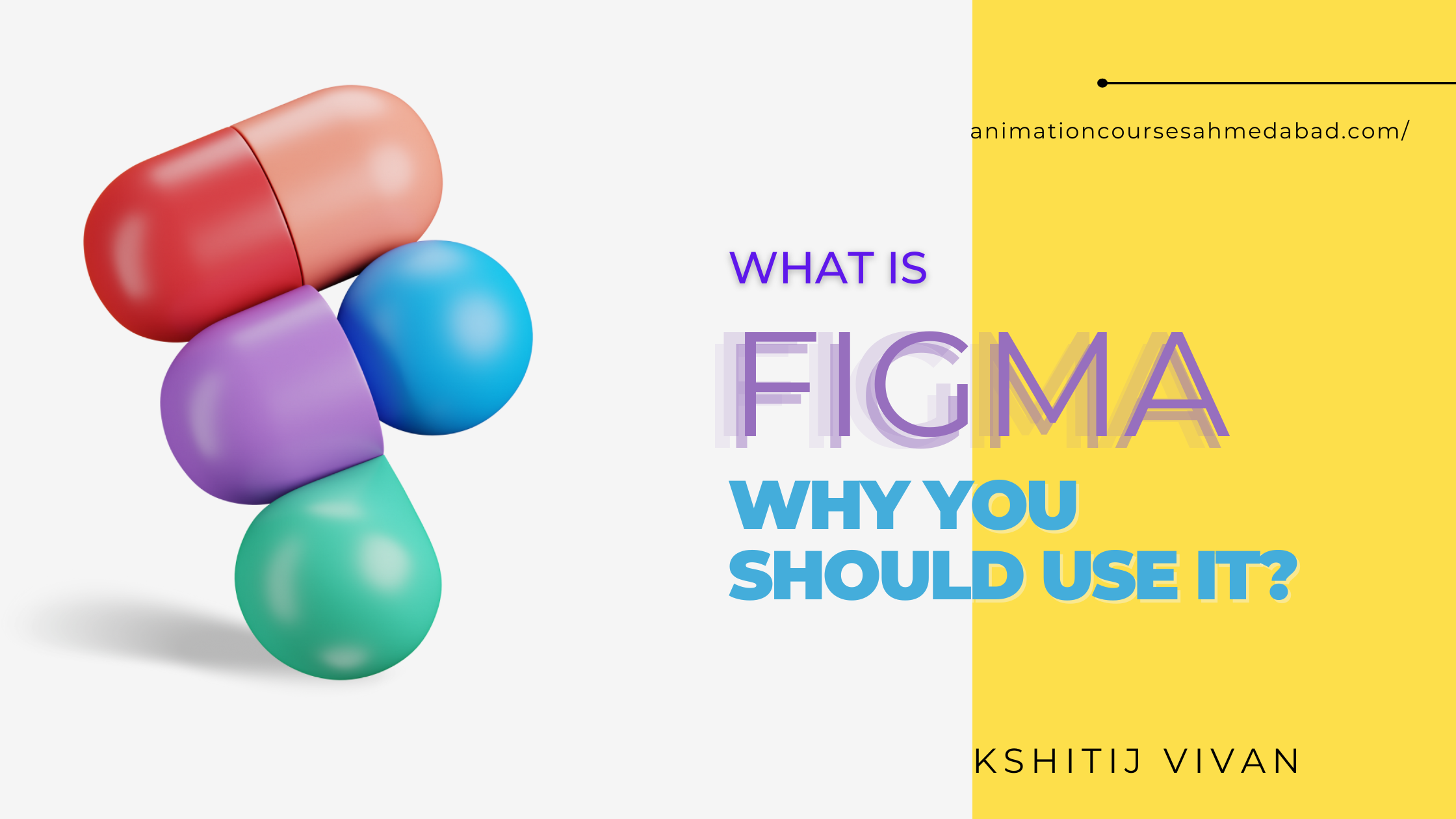
What Is Figma, Its Use, Difference, and Advantages: Start With Best course For UI UX Design
Ever come across this great designing tool named Figma? Do you want to know what this Figma is, and its use?
If you are from graphic designing community you may be using Photoshop, Illustrator, or Adobe XD, and now looking for more tools to do your work.
Through Figma, designers can collaborate with their team and clients using real-time editing and sharing capabilities.
But what exactly makes Figma stand out from the rest of the tools in the market?
In this post, we will explore what Figma is, its uses, and differences, and how you can take Figma courses In Ahmedabad that teach you how to use it.
What is Figma?
Figma is a cloud-based vector graphics editor and prototyping tool. It is available on macOS, Windows, and Linux. Figma has been described as "the Google Docs of design" because it enables real-time collaboration between designers. Unlike other design tools, Figma only supports vector graphics, making it more suitable for web and app design than for print design.
Figma is a powerful design and prototyping tool that has become increasingly popular in recent years.
It’s an all-in-one platform for creating interactive prototypes, user interfaces, and high-fidelity visuals for websites and apps.
Is Figma free?
Figma is a free online design platform that allows you to create, collaborate, and share your designs.
It is a vector-based design tool that is used by designers to create digital products and interfaces.
Figma is different from other design tools because it offers a real-time collaboration feature that allows multiple people to work on the same design at the same time. It also has a versioning feature that lets you go back and forth between different versions of your design.
What is Figma used for?
Figma is a vector graphics editor and prototyping tool it allows you to create and manipulate vector graphics, as well as create prototypes of your design.
It's used by both professional designers and hobbyists and has a wide range of features that make it suitable for a variety of tasks.
Some of the things that Figma can be used for include:
- Creating high-quality vector illustrations
- Designing web layouts
- Creating wireframes and prototypes
- Collaborating with other designers on projects
Figma usage in the industry
Figma is an incredible tool for designers, and it can be used for a variety of tasks.
- Web design: Figma offers an incredible web-based editor that allows you to create prototypes quickly and easily.
- Mobile app design: The mobile interface is just as easy to use as the desktop version, so you can make sure your designs look great on both screens.
- Icons: The icons library in Figma makes it easy to create icons quickly without having to learn any complicated software or design tools like Adobe Illustrator or Sketch.
- Illustration: It's not just for UI/UX! You can also use this software for illustration work because of its powerful vector capabilities and clean lines (both of which are key components when working with illustrations).
- Infographics: Again, don't think that because this is primarily a web-based tool it's not useful if you want to get into infographics—it's perfect! You'll find yourself creating beautiful illustrations with ease once you master the basics of Figma; once those skills are mastered, infographics will come naturally too!
Advantages of Figma
Figma is a vector-based design tool that is gaining popularity among designers and teams for its ease of use and collaboration features.
Some advantages of Figma include:
1. Ease of use: Figma has a clean interface and is easy to learn and use. This makes it a great tool for both beginners and experienced designers.
2. Collaboration features: Figma’s real-time collaboration features are great for team projects. Multiple designers can work on the same file at the same time, and see each other’s changes in real time. This can help speed up the design process and avoid miscommunications.
3. Cloud-based: Figma is cloud-based, so you can access your files from anywhere, on any device. This makes it a great tool for remote teams or designers who travel frequently.
4. Flexible pricing: Figma has a free plan that includes all the basic features you need to get started with design. For teams or power users, there are affordable monthly plans that offer additional features and storage space.
The difference between Figma and other design tools
When it comes to design tools, Figma is in a league of its own. Unlike other design tools, Figma is vector-based and uses a web-based interface, making it easy to use and accessible from anywhere. Figma also has some unique features that make it ideal for designing user interfaces, websites, and apps.
Here are some of the key differences between Figma and other design tools:
Vector-Based: With Figma, all your designs are created using vector graphics. This means that your designs can be resized and scaled without losing quality. Other design tools, such as Photoshop and Sketch, use raster graphics, which can pixelate when scaled up.
Web-Based: Figma is a web-based design tool, so there’s no need to download or install anything. This makes it easy to use on any computer or device, and you can even collaborate with others in real time. Other design tools require you to download and install software on your computer, which can be a hassle.
Unique Features: Figma has some features that set it apart from other design tools. For example, Figma allows you to create components and style guides, which makes designing consistent UIs much easier. Figma also has an intuitive version control system that lets you easily track changes and revert to previous versions if needed.
Figma vs Adobe XD
When it comes to Figma vs Adobe XD, there are a few key differences to consider. First and foremost, Adobe XD is a vector-based design tool while Figma is a Vector-based Web-based design tool. This means that with Adobe XD, you can create infinitely scalable graphics without losing any quality. With Figma, on the other hand, you can work on a cloud,
How to get started with Figma?
If you're new to Figma, don't worry - it's easy to get started!
Creating an account is free and only takes a few seconds. Just head over to figma.com and click on "Sign Up". Once you've entered your email address and chosen a password, you'll be ready to start using Figma.
Your first step in using Figma is creating a project. To do this, click on the "Create New Project" button in the top-left corner of the screen.
Then, give your project a name and choose whether you want it to be public or private.
Public projects can be seen by anyone with the link, while private projects can only be accessed by people who have been invited to join them.
Once you've created your project, it's time to start adding some content!
The easiest way to do this is by importing files from other design tools like Photoshop or Sketch.
To import a file, click on the "File" menu in the top-left corner of the screen and select "Import...". Then, choose the file you want to import and click "Open".
You can also create new files from scratch in Figma. To do this, click on the "+" icon in the bottom-left corner of the screen and select "New File".
Are there any Figma courses In Ahmedabad?
Figma courses are popping up all over the internet as more and more people discover powerful design tools. While there are many free resources available, taking a Figma course can help you learn the ropes faster and start using Figma like a pro.
Here are some of our favorite Figma courses:
Learn UI/UX Design with Figma - In this course, you'll learn everything you need to know about designing user interfaces with Figma. You'll start by setting up your workspace and learning the basics of the interface. Then you'll move on to creating layouts, working with typography, adding color and images, and creating interactive prototypes.
Learn UX Design - This comprehensive course will teach you everything you need to know about UX design, from research to wireframing to prototyping. You'll use Figma throughout the course
You can find here best institute for graphic design and UI UX design in Ahmedabad.
FAQ
Is Figma better than Adobe Illustrator?
That depends on what your needs are.
For example, if you're an individual designer looking for an affordable solution that gives you access to all of the tools needed to build beautiful UI layouts then Figma could be the right choice for your business needs.
If your team works mostly with static images and doesn't need any animation then maybe Illustrator would make more sense as there isn't currently support for animation features in their packages just yet (although this may change soon).
Why you should use Figma or learn it?
- Figma's interface looks simple.
The Figma interface is clean, simple, and intuitive. It's responsive, works well on mobile devices and it's easy to learn. The entire interface has been designed to be as intuitive as possible: you'll have no trouble getting started with your first project in no time at all.
- Figama has a community, plugins, and much more
Any new feature or addon requires plugins, adobe has a great chunk of plugins and resources, and Figma has a community too where people share plugins, resources, and many things.
Check out here why you should learn UI UX design as career.
What are Figma pricing plans?
Figma offers three levels of plans for teams: Basic, Advanced, and Enterprise.
The Basic plan is free, allowing you to create an unlimited number of projects for non-commercial use.
The Advanced plan has a monthly fee of $12 per user and includes the ability to add collaborators from outside your organization, access to all open source fonts as well as 500 GB storage space per user.
Finally, the Enterprise plan costs $75 per Figma editor/per month
$5 per FIGJAM editor/month.
In addition to these benefits, it also comes with custom domains for each project so that they can be branded appropriately
Is Figma better than Adobe Illustrator?
The answer is yes, but only for some things. Figma is a great tool for UI design and prototyping because it's cloud-based. Since it's in the cloud, you can make changes to your designs whenever you want without having to sync anything or worry about saving your work.
If something happens while you're working on an Illustrator file (like an accidental save or crash), that's it—you've lost all of your work!
This makes Figma a much better choice for creating digital interfaces because there are no worries about losing what took hours upon hours to create!
However, Adobe Illustrator remains the go-to tool for print design because it doesn't require any internet connection; instead of syncing files and making edits remotely like with Figma, designers just open up their projects locally on their computer where they'll be able to access them forever more without worrying about losing any data due to an accident with Wi-Fi connectivity issues or something similar happening during their workflow process."
Is Photoshop better than Figma?
Photoshop is better for more complex designs because it gives you more control over the details of your work.
It also has more options for print design, so if you’re looking to print something like a book cover or poster, Photoshop may be the way to go.
However, Figma has a simpler interface and is great for web design.
Why do designers use Figma?
You might be wondering why designers are using Figma, but not creating their websites or using a CMS like WordPress.
Figma is a design tool that allows you to create high-fidelity prototypes and share them with clients, colleagues, and other stakeholders.
It's not meant for building websites, nor does it have the same capabilities as prototyping tools like InVision Studio or Framer X (which are more focused on animations).
Is Figma for UI or UX?
So, you're a designer and want to learn how to make beautiful UIs. Or maybe you're a developer who wants to make your apps look amazing. Figma has something for both users and designers!
- Figma has been built from the ground up with both UI and UX in mind—and it's easy for any designer or developer to use.
Can Canva replace Figma?
While Canva is a great tool for creating images and designs, it's not as powerful as Figma.
You can't use it to create an animation or prototype in real time. It also doesn't have the same flexibility that you'd get with Figma's many features and customizability options.
Canva offers a limited feature set in comparison to Figma when it comes to creating designs that are professional and high quality.
Canva is a somewhat easy-to-use tool for any beginner who needs a design, while Figma is next level that brings in teams, and clients on the same platform that make the process easier and more efficient.
Here we have explained how to create a logo in canva, you can check it out.
If you need something beyond what Canva offers, then you should consider using another program like Adobe Illustrator or Photoshop instead of trying to do everything within Canva alone.
How can you learn Figma?
If you are interested to learn more about Figma online application use and create beautiful designs, posts, websites, and much more then we have a course that covers not only Figma app use but also designing from basics to advance level, you can check out here!
Conclusion
From this article, we can see that Figma is an incredibly useful tool for web and mobile app design.
Its user-friendly interface makes it easy to use and its wide array of features makes it an invaluable asset to any designer.
With the help of Figma, designers can quickly create beautiful designs without having to sacrifice quality or accuracy.
Figma has a variety of online courses available which can help users learn how to work with the platform more effectively.
All in all, anyone looking for a highly effective way to design web and mobile apps should look no further than Figma!



